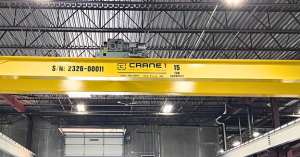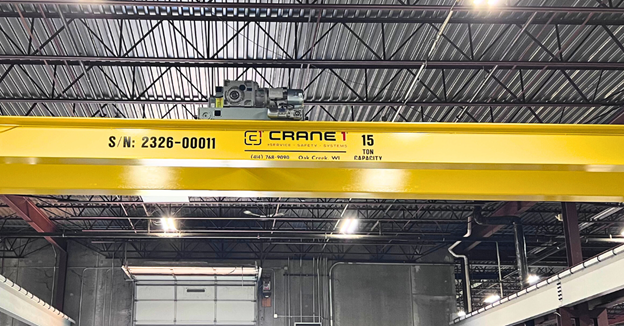Overhead crane systems play a crucial role in many industries by facilitating the safe and efficient movement of heavy loads. Whether employed in manufacturing plants, warehouses, shipyards, or construction sites, these cranes help improve operational workflows and increase productivity. However, like all mechanical systems, overhead cranes require periodic maintenance, upgrades, and modernizations to keep pace with technological advancements and changing operational needs.
Modernizing an overhead crane system may seem like an unnecessary investment at first glance, but it can provide significant returns over time. In this article, we will explore five key ways that overhead crane modernizations can boost your Return on Investment (ROI).

#1. Enhanced Safety Features Reduce Downtime and Liability Risks
Safety is a paramount concern in any workplace, and crane systems are no exception. Overhead cranes, if not regularly updated, may have outdated safety features that increase the risk of accidents. These risks not only jeopardize employee safety but also contribute to costly downtime, repairs, and potential legal liabilities.
Modernizing an overhead crane with the latest safety technologies, such as advanced load monitoring systems, collision sensors, and automatic braking systems, can help mitigate these risks. By incorporating these technologies, businesses can prevent accidents, avoid costly injuries, and reduce insurance premiums. Furthermore, more reliable safety features help ensure that workers can perform their tasks with confidence, increasing overall productivity.
The reduction in accidents and injuries directly correlates to lower operational costs and fewer disruptions in the workflow. This translates into a higher ROI as businesses can maintain continuous production and avoid the financial burden of workplace accidents and legal fees.
#2. Improved Crane Efficiency and Performance
Older crane systems are often less efficient, requiring more time to complete tasks and consuming higher amounts of energy. As these systems age, their motors, control systems, and components may wear down, leading to slower operational speeds and increased energy consumption. Over time, these inefficiencies can add up, significantly affecting the overall cost of operations.
One of the primary benefits of crane modernization is the improvement in efficiency and performance. Newer crane models come equipped with state-of-the-art control systems that optimize speed, precision, and load handling capabilities. Additionally, modern cranes are designed to be more energy-efficient, utilizing variable frequency drives (VFDs) that adjust motor speeds based on demand. This leads to a reduction in energy consumption, contributing to both cost savings and a more environmentally friendly operation.
Moreover, newer cranes often feature predictive maintenance capabilities, allowing operators to identify potential issues before they become serious problems. This proactive approach to maintenance can reduce downtime and keep the crane system operating at peak performance, which directly boosts ROI by improving productivity and reducing maintenance costs.
#3. Extended Equipment Lifespan Reduces Capital Expenditures
Replacing old and outdated cranes with brand-new systems can be a substantial capital investment. However, this cost can be avoided by modernizing existing crane equipment. Overhead crane modernizations can extend the life of a crane by addressing wear and tear on key components and incorporating newer technologies that improve overall functionality.
By upgrading the crane’s components, such as hoists, trolleys, control systems, and brakes, businesses can achieve the benefits of new equipment without the high upfront costs of a complete replacement. Many crane components, including motors and controls, can be retrofitted with more advanced systems, allowing businesses to continue utilizing their existing infrastructure while gaining the benefits of newer technology.
Not only does this approach reduce capital expenditures, but it also lowers long-term operational costs. A crane that has been well-maintained and modernized will likely require fewer repairs and experience less downtime, ensuring that it remains productive for many more years. This extension of the crane’s useful life helps businesses achieve a better ROI compared to purchasing new equipment.
#4. Increased Load Handling Capacity and Flexibility
As businesses grow and their operations expand, their overhead crane systems may need to handle heavier loads or perform more diverse tasks. Older cranes may lack the capacity to handle these increased demands, leading to the need for additional equipment or the replacement of existing cranes altogether.
Overhead crane modernizations can increase its load handling capacity and flexibility, allowing it to better meet the demands of a growing business. By upgrading key components such as hoists, winches, and lifting mechanisms, cranes can be configured to handle heavier or more complex loads. Additionally, modern cranes can be fitted with advanced control systems that improve precision and enable more complex movements, providing greater flexibility in how the crane is used.
This increase in load handling capacity and flexibility can boost productivity by reducing the need for additional equipment or personnel. It can also help businesses expand their range of operations, offering the opportunity to take on more diverse projects and increasing revenue potential. In turn, this contributes to a higher ROI as the crane system is utilized to its fullest potential.
#5. Compliance with Industry Regulations and Standards
In many industries, compliance with safety standards and regulations is mandatory. Regulations regarding crane operations, such as OSHA (Occupational Safety and Health Administration) guidelines in the United States, can change over time, and older crane systems may no longer meet current compliance requirements. Non-compliance can result in fines, penalties, and legal issues that can be costly for businesses.
Overhead crane modernizations are an effective way to ensure that equipment remains compliant with the latest industry standards and regulations. Modernization efforts may include upgrading safety features, control systems, and electrical components to align with updated regulatory requirements. By proactively addressing compliance, businesses can avoid fines and potential shutdowns that could negatively impact productivity.
Additionally, maintaining compliance ensures that the crane system operates safely and efficiently, which is essential for long-term operational success. This approach not only mitigates legal risks but also helps businesses maintain a reputation for safety and reliability, which can enhance their relationships with customers and clients. A modernized crane that meets regulatory standards can therefore contribute to a higher ROI by reducing the risk of costly penalties and improving overall operational integrity.
Overhead crane modernizations offer significant benefits that directly contribute to a higher Return on Investment. By enhancing safety features, improving crane efficiency, extending equipment lifespan, increasing load handling capacity, and ensuring compliance with regulations, businesses can improve their operational performance while reducing costs.
As the industry leader for overhead cranes, our Crane 1 Services team specializes in providing the best overhead crane modernizations and overhead crane upgrades to help reduce our customers’ downtime costs and improve their operational output. Contact Crane 1 Services today to learn how our team can maximize your overhead crane’s ROI.
